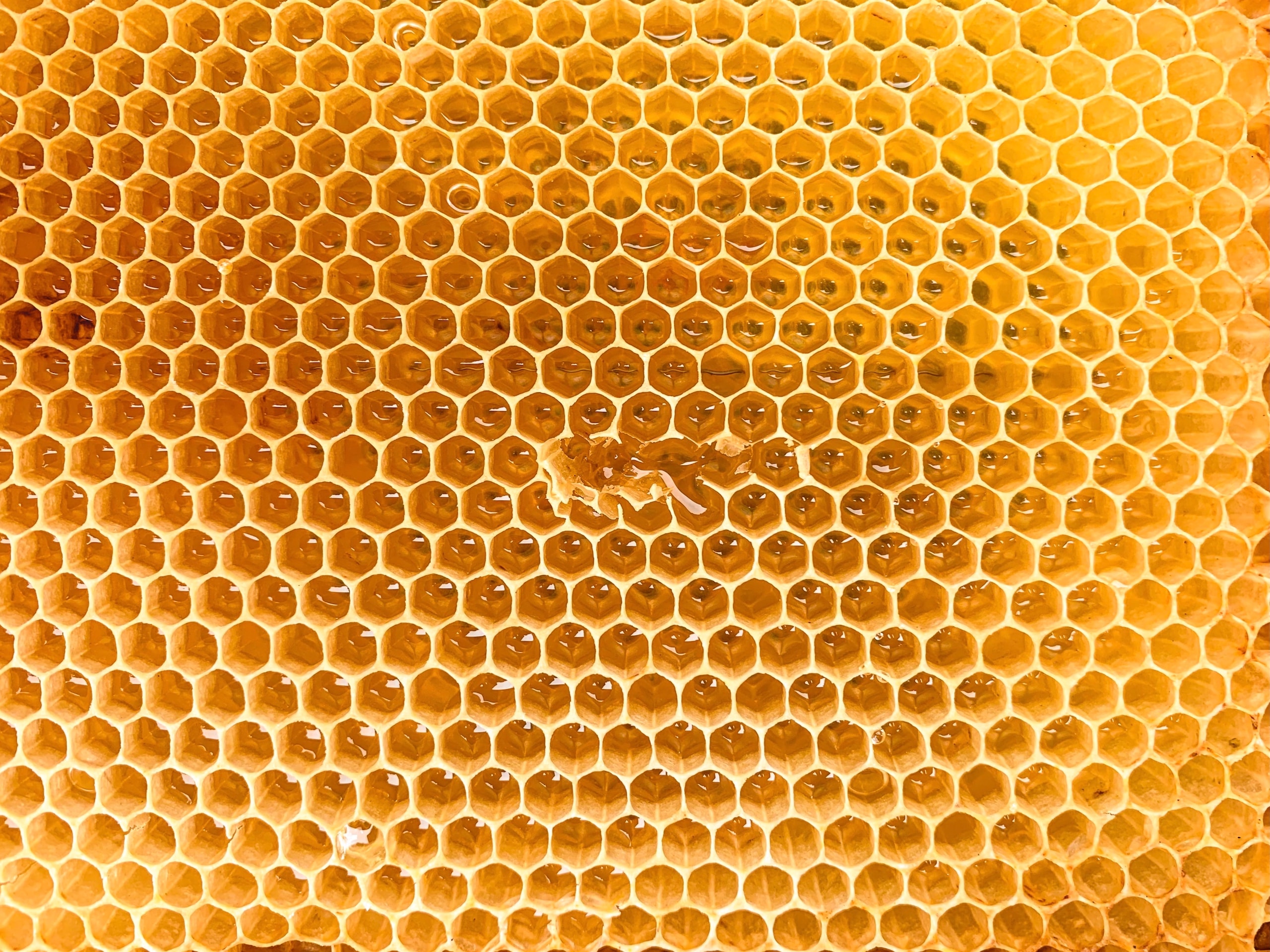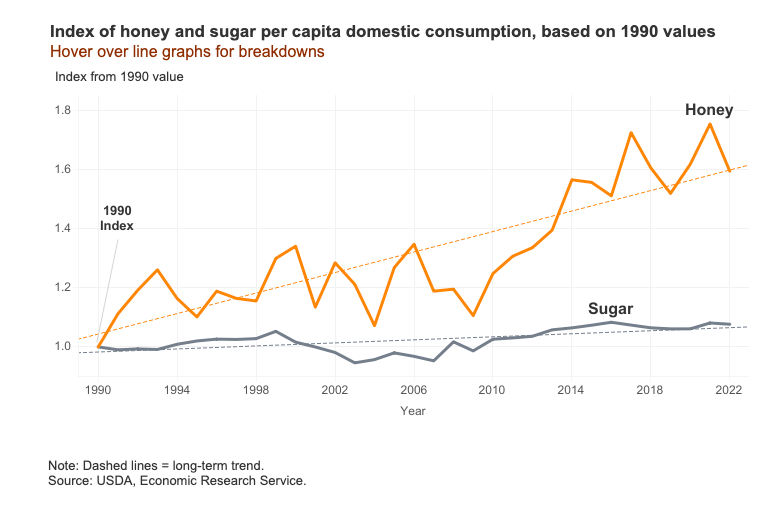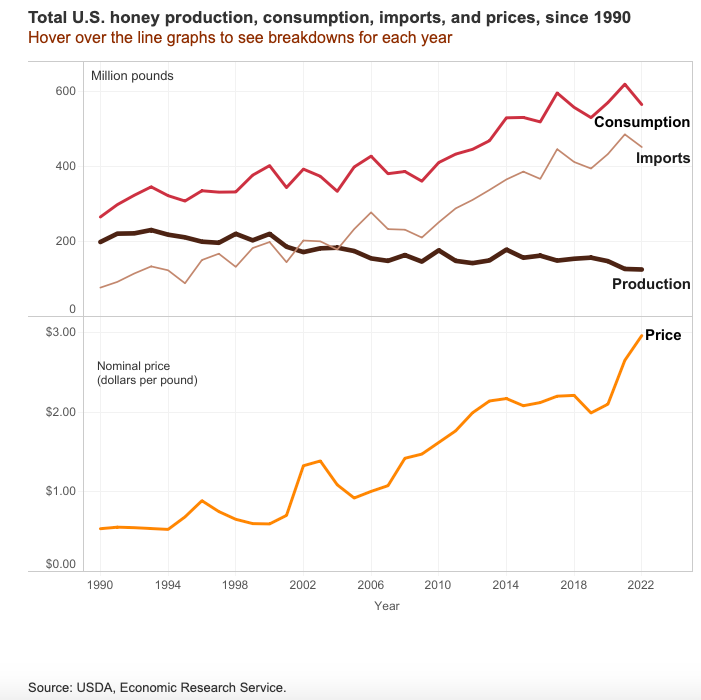Honey, the boom in the United States and the difficulty of producing it in Italy

In the United States, the per capita consumption of honey has increased by 60% because it is considered a superfood, but both the States and Italy, where less honey is consumed than in the rest of Europe, are struggling to produce it and consequently imports are increasing from countries that are not too transparent in terms of food safety. Facts, numbers and comments
That Americans go crazy for sugar is nothing new, but in the United States it is the imports of another sweetener that surprises: those of honey. Perhaps because in reality it is not a simple sweetener but a food rich in properties and an ally of our health.
THE CONSUMPTION OF SUGAR VS HONEY IN THE UNITED STATES
The United States, Quartz reports, imports more sugar and confectionery than any other country in the world. Suffice it to say that in 2022 they spent 6.48 billion dollars on sugar. Then follow China (3.63 billion), Indonesia (3.45 billion), Germany (1.92 billion) and the United Kingdom (1.69 billion).
It is also calculated that every American consumes almost 70 kilos of sugar a year between drinks and sugary foods and about 600 grams of honey. Although there is no comparison between these two figures, the US Department of Agriculture (USDA) notes that while the per capita consumption of sugar has grown by only 7% since 1990 that of honey, in the same time period, has increased by 60%, mainly thanks to its reputation as a “superfood” – such as garlic, ginger and turmeric.

HOW MUCH HONEY DOES THE UNITED STATES IMPORT
Demand for honey and its products, according to the USDA, not only remains high but has also increased significantly over the past three decades, growing more than that of sugar.
However, the greater demand for honey in the United States – also due to climate change – cannot be satisfied with domestic production, which in 2022 reached 57 million kilos against 105 million kilos in 1993, or 46% in less than the country's peak production.
That's why to meet demand, honey imports into the United States have grown an average of 7% per year over the past 30 years and since 2005 have exceeded domestic production, so much so that the USDA had projected that in 2022 75% of the honey consumed would have been imported. The countries from which it comes are different, but in recent years India, Argentina and Vietnam have been the main exporters and in 2022 they accounted for 61% of US honey imports.
With production declining, the national average price paid to producers in 2022 was plus or minus $3 per pound (about 450 grams), surpassing last year's record of $2.65.

CONSUMPTION, PRODUCTION AND IMPORT OF HONEY IN ITALY
Even in our country, the production of honey is declining. Between the poor health of bees, influenced by environmental stress factors – such as extreme weather events, parasites, pathogens, seed treatments in agriculture -, and climate change that in 2023 recorded first an anomalous cold and then an anomalous drought, a drop of up to 80% in 2022 of spring honey production is estimated.
“A figure that compares with last year's production of 23,500 tons, up on the previous year but largely below the potential which has decreased by 23% in the last decade”, writes Il Sole24Ore quoting Coldiretti .
Therefore, even Italy, where about half a kilo of honey per capita is consumed per year (the European average is 600 grams), is forced to import it more and more often. According to Coldiretti data , in fact, in 2022 imports increased by 12% for a quantity of over 26.5 million kilos, "also coming from countries that do not always shine for transparency and food safety". In particular, arrivals from Turkey grew by 146%, from China by 66%, from Romania by 134% and from Ukraine by 83%.
Furthermore, according to the "From the hives" survey of the European Commission's Joint Research Center (JRC), among the samples imported between 2021 and 2022, almost 1 in 2 (46%) are suspected of adulteration, with the number absolute highest recorded by China (74%), that of suspect samples (93%) by Turkey and 'doubtful' (100%) by the United Kingdom. This is probably because, says Coldiretti, "it is honey produced in other countries and further blended before being sent back to Europe".
This is a machine translation from Italian language of a post published on Start Magazine at the URL https://www.startmag.it/economia/miele-il-boom-negli-stati-uniti-e-la-difficolta-di-produrlo-in-italia/ on Sat, 02 Sep 2023 06:05:33 +0000.
